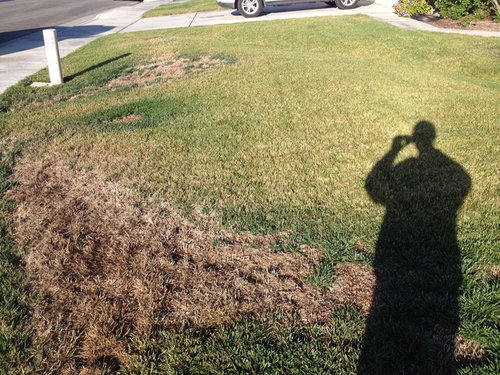Need lawn help. Large brown spots.
MDK04
10 years ago
Related Stories

GARDENING GUIDESHow to Fix Bare and Yellow Lawn Spots
Restore your turf’s good looks by reseeding unsightly patches
Full Story
GARDENING GUIDES8 Unthirsty Plants Help You Save Water in Style
Spend less effort and money on your landscape with drought-tolerant and native plants that liven up your yard
Full Story
PATIOSAn Outdoor Dining Spot Creates Quiet Time in the Heart of San Francisco
See how this abandoned site became a big-city oasis with the help of a new lawn and a unique outdoor dining area
Full Story
MOST POPULARMeet a Lawn Alternative That Works Wonders
Carex can replace turfgrass in any spot, is low maintenance and adjusts easily. Add its good looks and you’ve got a ground cover winner
Full Story
EARTH DAYThe Case for Losing the Traditional Lawn
Work less, help the environment and foster connections by just saying no to typical turf
Full Story
PETSHow to Help Your Dog Be a Good Neighbor
Good fences certainly help, but be sure to introduce your pup to the neighbors and check in from time to time
Full Story
PETS6 Ways to Help Your Dog and Landscape Play Nicely Together
Keep your prized plantings intact and your dog happy too, with this wisdom from an expert gardener and dog guardian
Full Story
GARDENING AND LANDSCAPINGBe a Citizen Scientist to Help Wildlife, Learn and Have Fun Too
Track butterflies, study birds, capture stars ... when you aid monitoring efforts, you’re lending Mother Nature a hand
Full Story
SELLING YOUR HOUSE10 Low-Cost Tweaks to Help Your Home Sell
Put these inexpensive but invaluable fixes on your to-do list before you put your home on the market
Full Story









MDK04Original Author
MDK04Original Author
Related Professionals
Baltimore Landscape Architects & Landscape Designers · Erie Landscape Architects & Landscape Designers · Aurora Landscape Contractors · Barrington Landscape Contractors · Brandon Landscape Contractors · El Sobrante Landscape Contractors · Gurnee Landscape Contractors · La Verne Landscape Contractors · Lorain Landscape Contractors · Plainview Landscape Contractors · Rockwall Landscape Contractors · Wickliffe Landscape Contractors · Wilsonville Landscape Contractors · Shenandoah Landscape Contractors · Spring Swimming Pool BuildersMDK04Original Author
dchall_san_antonio
MDK04Original Author
mulchmama